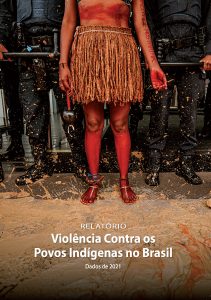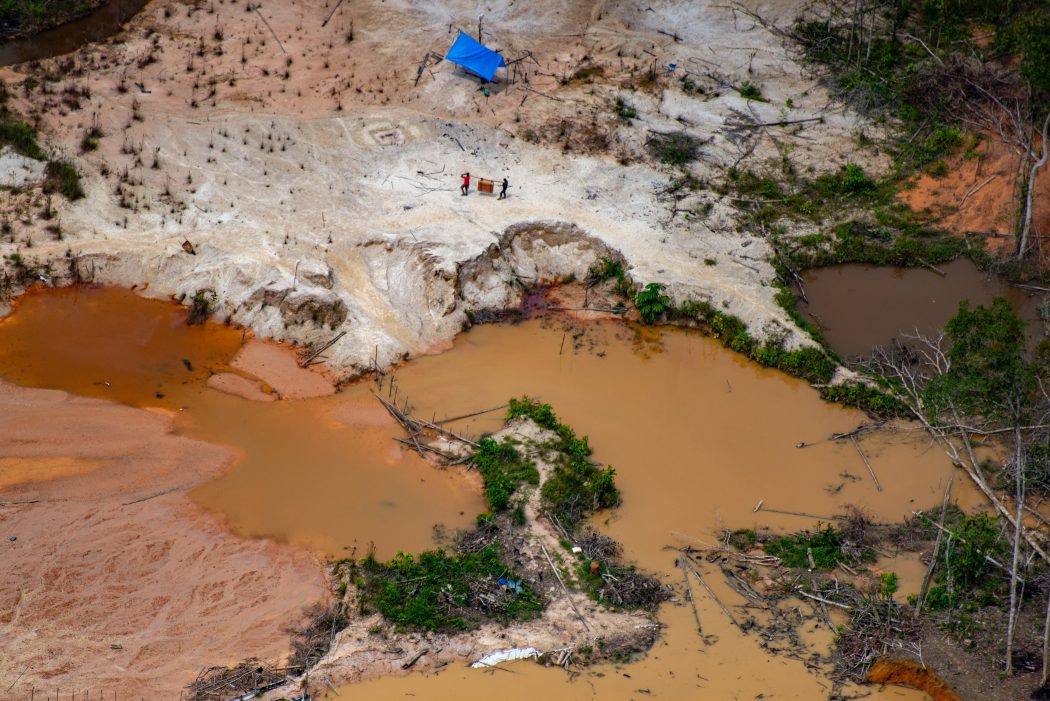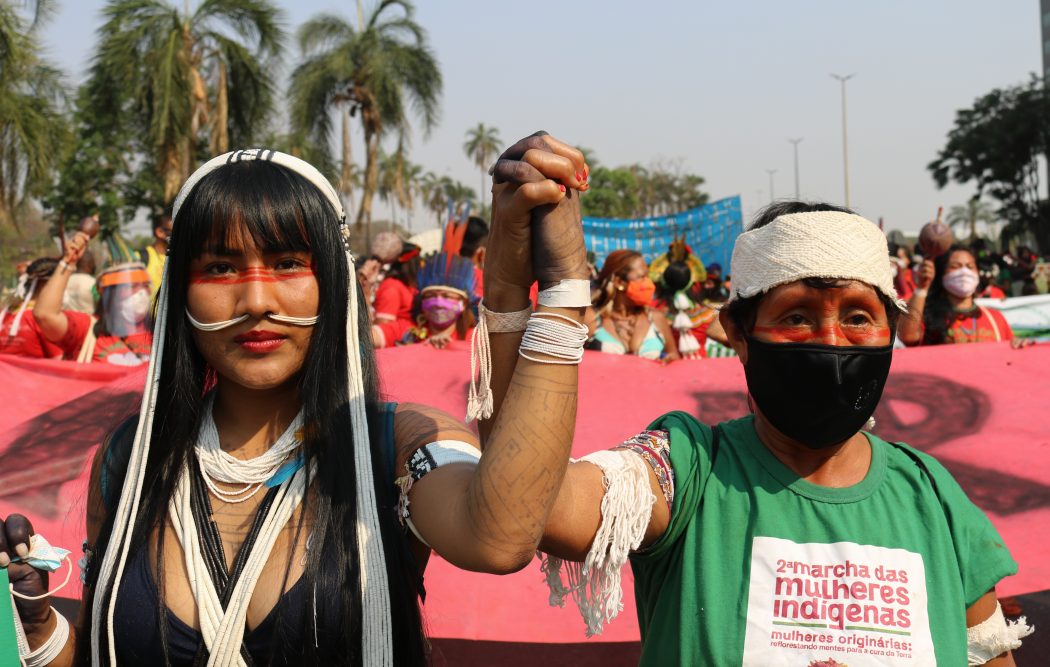
The year of 2021 was marked by a deepening and a dramatic intensification of violence and rights violations against the indigenous peoples of Brazil. The increase of invasion of indigenous lands (TI; Terra Indigena), attacks against indigenous villages and indigenous leaders as well as the intensification of conflicts showing the institutional atmosphere of an attack against the constitutional rights of Brazils indigenous people. This is pointed out by the report Violence Against Indigenous Peoples of Brazil – data from 2021, an annual publication of the Indigenous Missionary Council (Cimi).
In its third year, the government of Jair Bolsonaro maintained the directive of the paralysation of the demarcations of indigenous lands and complete omission regarding the protection of indigenous lands already demarcated. From the point of view of the official indigenous policy, that position has represented continuity compared to the last two years, but in the point of view of the indigenous peoples it has represented the escalation of a situation that was already violent and terrifying.
The consequence of this stance was the increase, for the sixth consecutive year, in cases of “possessory invasions, illegal exploitation of resources and damage to property”. In 2021, Cimi reported 305 cases of that kind, which affected at least 226 indigenous lands in 22 states of Brazil.
In the previous year, 263 cases of invasion had affected 201 indigenous lands in 19 states. The number of such cases is almost three times bigger than those ones reported in Cimis 2018 annual report, when 109 cases of that kind were accounted.
The report registered an increase in 15 of the 19 categories of violence systematised by the publication compared to the previous year and a huge amount of indigenous lives taken
In addition to the quantitative increase in cases and lands affected by illegal activities of miners, loggers, hunters, fishermen and land grabbers, among others, the invaders intensified their presence and brutality of their actions in indigenous territories.This situation was made explicit in cases such as of the Munduruku people, in Pará State and of the Yanomami people, in Roraima and Amazonas State. In the Yanomami indigenous land, where the presence of more than 20 thousand prospectors is estimated, the invaders began to carry out systematic armed attacks against the indigenous communities, spreading a climate of terror and causing deaths, including of children.
These violent and criminal attacks, often with heavy weapons, have been repeatedly reported by the indigenous people and ignored by the federal government, which continued to stimulate mining activities in these territories. Illegal gold miners, in addition, served as a vector for diseases such as Covid-19 and of malaria in the case of the Yanomami indigenous People.
In Pará State, gold miners who work illegally in the Munduruku indigenous lands attacked the headquarter of an association of indigenous women, tried to prevent the travelling of leaders of the indigenous people for demonstrations in Brasília, made death threats and even burned the house of an indigenous leader down – in retaliation for her stance against mining in the territory. While these actions were taking place, the Munduruku indigenous land continued to be devastated, with rivers and streams being destroyed by the heavy machinery used in the illegal extraction of gold.
The report registered an increase in 15 of the 19 categories of violence systematised by the publication compared to the previous year and a huge amount of indigenous lives taken. There were 176 murders of indigenous people – just six less than in the year 2020, which recorded the highest number of homicides since Cimi started to count this data based on public sources, back in 2014. The number of 148 suicides of indigenous people in 2021 was the highest ever recorded in the same period.
The general context of attacks on indigenous territories, leaders and communities is related to a series of measures by the Executive power that favours the exploitation and private appropriation of indigenous lands and actions of the federal government and its allied base to pass laws aimed at dismantling the constitutional protection of indigenous peoples and their territories.
This is the case of measures such as Normative Instruction 09, published by Funai in 2020, that released the certification of private properties on indigenous lands not
homologated and the Joint Normative Instruction of Funai and Ibama which, in 2021, started to allow the economic exploitation of indigenous lands by associations and “mixed composition”-organisations between indigenous and non-indigenous people.
Proposals such as the law proposal (PL) 490/2007 also had this character, which makes new demarcations off indigenous land impossible and opens the indigenous lands already demarcated and thus protected to predatory exploitation. The law proposal PL 191/2020, authored by the federal government itself intends to allow mining in indigenous lands. This set of legal actions gave land invaders and criminal groups confidence to proceed with their illegal actions in the indigenous lands.
Illegal gold miners developed extensive infrastructure, invaders expanded the deforestation for the opening of pastures and the planting of monocultures, and hunters, fishermen and loggers intensified their incursions into the indigenous territories. The attempt to approve these law projects, the context of the offensive against their rights and the worsening of the situation in the territories motivated strong mobilisations of indigenous peoples throughout the country, with two large national protest camps in Brasília.
Despite several actions by the Federal Public Ministry (MPF), this was the third year in which the President of the Republic fulfilled his promise not to demarcate any indigenous lands

Milhares de garimpeiros atuam ilegalmente na TI Yanomami, sob o olhar conivente do Estado. Registro da devastação feito em abril de 2021. Foto: Christian Braga/Greenpeace
Violence against Heritage
The first chapter of the report brings together the “Violence against the Heritage” of indigenous people, divided into three categories. In this section, the following data were recorded: omission and delay in land regularisation (871 cases); territorial rights-related conflicts (118 cases); and possessory invasions, illegal exploitation of natural resources and miscellaneous damage to property (305 cases). The records thus add up to a total of 1.294 cases of violence against the heritage of indigenous peoples in 2021.
Despite several actions by the Federal Public Ministry (MPF), this was the third year in which the President of the Republic fulfilled his promise not to demarcate any indigenous lands. An update of Cimi’s land bank and indigenous territorial demands identified that, of the 1.393 indigenous lands in Brazil, 871 (62%) remain pending for their regularisation. Of these, 598 are areas claimed by indigenous peoples that do not count with action by the State to initiate the demarcation process. Also noteworthy in this category is the burning of central spaces for spirituality customs of different indigenous communities. Four cases were recorded in Mato Grosso do Sul, involving the Guarani and Kaiowá peoples, and one in Rio Grande do Sul, with the Guarani Mbya people.
Among the cases of conflicts over territorial rights are the various records of overlapping Rural Environmental Registry (CAR) within indigenous lands and certification of private property on indigenous lands. In some cases, as in the Uru-Eu-Wau-Wau indigenous land, in Rondônia, and Barra Velha, in Bahia, there was an attempt to sell indigenous land through social platforms.
The report also records cases of murders of indigenous youth and children carried out with extreme cruelty and brutality

II Marcha Nacional das Mulheres Indígenas, em setembro de 2021, em Brasília (DF). Foto: Verônica Holanda/Cimi
Violence against the Person
Regarding the cases of “Violence against the Person”, which are systematised in the second chapter of the report, the following data were recorded: abuse of power (33); threat of death (19); various threats (39); murders (176); wrongful death (20); bodily injury deceitful (21); ethnic-cultural racism and discrimination (21); attempted murder (12); and sexual violence (14).
The records total 355 cases of violence against indigenous people in 2021, the highest number recorded since 2013, when the case counting method was changed. In 2020, 304 such cases had been cataloged. The states that recorded the highest number of murders of indigenous people in 2021, according to data from the Mortality Information System (SIM) and from state secretariats of health, were Amazonas (38), Mato Grosso do Sul (35) and Roraima (32). The three states also recorded the highest number of murders in 2020 and 2019. Among the cases that stand out in this context are two murders of indigenous people from the Tembé people, in the Alto Rio Guamá indigenous land, in Pará State. Isac Tembé, a 24-year-old teacher, was killed by military police officers when he hunted with other youths of his people in an area close to their territory; weeks later, Benedito Cordeiro de Carvalho, known as Didi Tembé, was also shot to death in circumstances that are still unclear.
The report also records cases of murders of indigenous youth and children carried out with extreme cruelty and brutality. In 2021, the murders of Raíssa Cabreira Guarani Kaiowá, only 11 years old, and Daiane Griá Sales, from the Kaingang people, of 14 years. Both were raped and killed.
A large part of the occurrences of omission and lack of assistance are linked to the context of the Covid-19 pandemic, especially in relation to the lack of care and health teams and lack of access to water and basic sanitation

Acampamento Luta pela Vida, agosto de 2021, Brasília (DF). Foto: Marina Oliveira/Cimi
Violence by Omission of the Public Power
The cases of “Violence by Omission of the Government”, registered in the third chapter of the report, also show an overall increase in almost all categories in relation to the year 2020, with the exception of cases of “general lack of assistance” and childhood mortality.
Based on the Access to Information Law (LAI), Cimi obtained from the Special Health Department (Sesai) partial information on the deaths of indigenous children aged 0 to 5 years old age. The data, which were collected by Cimi in January 2022 reveal the occurrence of 744 deaths of indigenous children from 0 to 5 years old in 2021.
The Brazilian states with the highest number of deaths in this age group were Amazonas (178), Roraima (149) and Mato Grosso (106). Despite the likely lag of data for 2021, the number of child deaths was only higher during 3 years in the last decade, in 2014 (785), 2019 (825) and 2020 (776). Data from SIM and state health departments record the occurrence of 148 suicides of indigenous people in 2021. The states with the most cases were Amazonas (51), Mato Grosso do Sul (35) and Roraima (13).
Also in this third chapter, the following data were recorded: general lack of assistance (34 cases); lack of assistance in the area of indigenous school education (28); healthcare assistance (107); dissemination of alcohol and other drugs (13); and death due to lack of health assistance (39), totalling 221 cases. In 2020, records in these categories had totalled 177 cases.
A large part of the occurrences of omission and lack of assistance are linked to the context of the Covid-19 pandemic, especially in relation to the lack of care and health teams and lack of access to water and basic sanitation. This situation was exacerbated by the actions of misinformation about vaccines against Covid-19, which occurred in several regions. Many indigenous people, especially in urban contexts, reported cases of denial of access to Covid vaccine, despite the determination of the Federal Supreme Court (STF) that all indigenous peoples should be included in the priority immunisation group, regardless of their place of residence.
Deaths from Covid-19
Despite the start of vaccination, SIM data analysed by Cimi register 847 deaths from indigenous people due to coronavirus infection in 2021. The number is more than double as registered by Sesai, which indicates the occurrence of 315 deaths of the type in the same period. SIM unifies data on deaths in Brazil, while Sesai covers only the indigenous population served by the Indigenous Health Care Subsystem, estimated of at about 755 thousand people.
The most comprehensive data provide an indication of possible underreporting of cases and of the large number of indigenous people, who faced the pandemic in cities, forest camps or re-occupied territories and retakes and died without public assistance.

Invasão possessória na TI Piripkura, onde vivem indígenas em isolamento voluntário, registrada em julho de 2021. Foto: Christian Braga/Greenpeace
Isolated indigenous peoples
The situation of indigenous peoples in voluntary isolation has also reached deep seriousness, with the practice adopted by the Bolsonaro government of renewing the regulations that restrict access to areas with the presence of these isolated indigenous peoples for periods of only six months – or not even renew them at all, as in the case of the Jacareúba-Katawixi Indigenous Land, which means the isolated people have no protection since December 2021 in their region.
The land invasions affected at least 28 indigenous lands where there is a presence of isolated indigenous peoples, putting the very existence of these indigenous groups at risk. These areas concentrate 53 of the total of 117 records of isolated indigenous peoples maintained by the Cimi Support Team for Free Indigenous Peoples, which analyses this situation in the fourth chapter of the report.
Articles and memory
The report also features special articles that analyse the situation of indigenous people locked up in Brazil, the relationship between racism and violence against indigenous peoples and the Bolsonaro government’s indigenous-policy from the perspective of budget execution. The last chapter of the report, dedicated to the theme of “Memory and Justice”, proposes a reflection on mechanisms for reparation and non-repetition of violations against indigenous peoples.
Translated from Brazilian Portugues by Oliver Salge